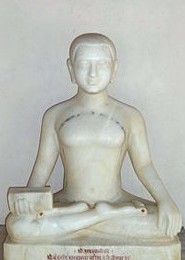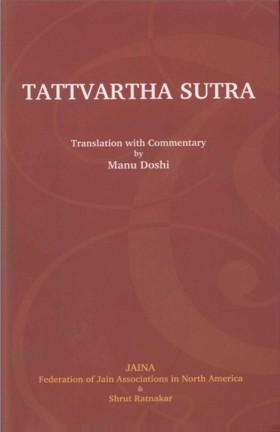04.29 Sthitih
| Audio: | |
| Sanskrit: | स्थिति |
| Hindi: | आयु का वर्णन किया जाता है। |
04.30 Bhavaneshu Dakshinārdhādhīpateenam Palyop-amamadhyardham
| Audio: | |
| Sanskrit: | भवनेषु दक्षिणार्धाधिपतीनां पल्योपममध्यर्धम् । |
| Hindi: | भवनों में दक्षिणार्ध के इन्द्रों की स्थिति डेढ़ पल्योपम है। |
04.31 Sheshānām Pādone
| Audio: | |
| Sanskrit: | शेषाणां पादोने । |
| Hindi: | शेष इन्द्रों की स्थिति पौने दो पल्योपम है। |
04.32 Asurendrayoh Sāgaropamamadhikam Cha
| Audio: | |
| Sanskrit: | असूरेन्द्रयो: सागरोपममधिकं च । |
| Hindi: | दो असुरेन्द्रों की स्थिति क्रमशः सागरोपम और कुछ अधिक सागरोपम है। |
04.33 Saudharmādishu Yathākramam
| Audio: | |
| Sanskrit: | सौधर्मादिषु यथाक्रमम् । |
| Hindi: | सौधर्म आदि देवलोकोण में क्रमशः निम्नोक्त स्थिति है। |
04.34 Sāgaropame
| Audio: | |
| Sanskrit: | सागरोपमे । |
| Hindi: | सौधर्म में स्थिति दो सागरोपम है। |
04.35 Adhike Cha
| Audio: | |
| Sanskrit: | अधिके च । |
| Hindi: | ऐशान में स्थिति कुछ अधिक दो सागरोपम है। |
04.36 Sapta Sanatkumāre
| Audio: | |
| Sanskrit: | सप्त सानत्कुमारे । |
| Hindi: | सानत्कुमार में स्थिति सात सागरोपम है। |
04.37 Visheshtrisaptadashaikādashtrayodashpanch-adashabhiradhikāni Cha
| Audio: | |
| Sanskrit: | विशेषत्रिसप्तदशैकादशत्रयोदशपञ्चदशभिरधिकानि च । |
| Hindi: | माहेन्द्र से आरण-अच्युत तक क्रमशः कुछ अधिक सात सागरोपम, तीन से अधिक सात सागरोपम, सात से अधिक सात सागरोपम, दस से अधिक सात सागरोपम, ग्यारह से अधिक सात सागरोपम, तरह से अधिक सात सागरोपम, पन्द्रह से अधिक सात सागरोपम स्थिति है। |
04.38 Aranāchyutādoordhwamekaikena Navasu Graiveyakeshu Vijayādishu Savārthasiddhe Cha
| Audio: | |
| Sanskrit: | आरणाच्युतादूर्ध्वमेकैकेन नवसु ग्रैवेयकेषु विजयादिषु सर्वार्थसिद्धे च । |
| Hindi: | आरण-अच्युत के ऊपर नौ ग्रैवेयक, चार विजयादि और सर्वार्थसिद्ध में स्थिति अनुक्रम से एक-एक सागरोपम अधिक है। |
04.29-38
English: These sutras deal with the maximum life spans. Bhavanapati area consists of ten abodes as mentioned in Sutra 4.11. Each of them is divided into northern and southern halves. In Asurkumār abode, the chief of southern half (known as Chamar) has a life span of one Palyopam, while that in northern half (known as Bali) has a little longer than that. In the rest of Bhavanapati abodes the chiefs of southern halves have a life span of one and a half Palyopam, while those of northern halves have one and three-quarter Palyopam.
There are twelve realms of Vaimanik beings as mentioned in sutra 4.20. Of these, the maximum life span in the first realm (Saudharma) is of two Sāgaropams, in the second (Aishān) it is a little more and in the third (Sānat) it is seven Sāgaropams. In fourth (Māhendra) it is more than seven, in fifth (Brahmalok) it is more than ten, in sixth (Lāntak) it is more than fourteen, in seventh (Mahāshukra) it is more than seventeen, in eighth (Sahasrār) it is more than eighteen, in ninth (Ānat) and tenth (Prānat) it is more than twenty and in eleventh (Aran) and twelfth (Achyut) it is more than twenty-two. In Graiveyak realms the life span goes on increasing by one Sāgaropam each till īt reaches 31 Sāgaropams in 9th Graiveyak. In four Anuttar realms it is 32 Sāgaropams and in Sarvārrthasiddhi it is 33 Sāgaropams.
 Acharya Umaswati
Acharya Umaswati
